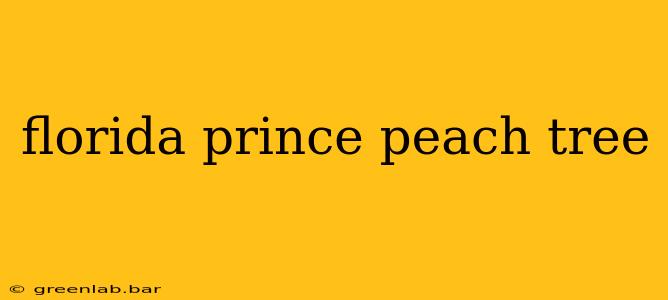The Florida Prince peach tree is a popular choice among Florida peach growers, known for its adaptability to the state's warm climate and its delicious fruit. This guide delves into the specifics of cultivating this variety, providing crucial information for both experienced orchardists and enthusiastic home gardeners.
Understanding the Florida Prince Peach
The Florida Prince stands out due to its early-season ripening, typically producing a bountiful harvest in late spring. Its fruit is characterized by a juicy, sweet flesh with a balanced sugar-acid ratio, making it ideal for fresh eating, canning, or preserving. Unlike some other peach varieties, the Florida Prince boasts a relatively firm texture, making it easier to handle and transport. Its attractive appearance, with a vibrant blush on a yellow background, further enhances its market appeal.
Key Characteristics:
- Early Ripening: A significant advantage in Florida's often unpredictable weather patterns.
- Sweet Flavor Profile: A well-balanced sweetness, pleasing to a wide range of palates.
- Firm Fruit: Reduces bruising and extends shelf life compared to softer varieties.
- Attractive Appearance: Enhances market value and consumer appeal.
- Moderate Chill Hours: Adaptable to Florida's milder winters, requiring fewer chilling hours than many northern peach cultivars. (Note: Specific chill hour requirements should be verified with local agricultural extension services).
Planting and Care: A Step-by-Step Guide
Successful Florida Prince peach cultivation hinges on proper planting and ongoing care. Follow these steps for optimal results:
Site Selection:
- Sunlight: Choose a location with at least 6-8 hours of direct sunlight daily.
- Soil Drainage: Well-drained soil is essential to prevent root rot. Amend heavy clay soils with organic matter to improve drainage.
- Spacing: Allow adequate spacing between trees (approximately 15-20 feet) for optimal growth and air circulation.
- Wind Protection: Consider windbreaks to protect young trees from strong winds, which can damage branches and fruit.
Planting:
- Planting Time: The best time to plant is during the dormant season (late fall or winter).
- Planting Depth: Plant the tree at the same depth it was growing in the container.
- Watering: Thoroughly water after planting and maintain consistent moisture during establishment.
Ongoing Care:
- Watering: Regular watering is vital, especially during dry periods. Deep, infrequent watering is better than shallow, frequent watering.
- Fertilizing: Apply a balanced fertilizer according to soil test recommendations. Nitrogen is crucial for vegetative growth, but avoid over-fertilizing, which can lead to excessive leaf growth at the expense of fruit production.
- Pruning: Regular pruning is necessary to maintain tree shape, encourage fruiting, and prevent disease. Consult local agricultural resources for specific pruning techniques suitable for Florida Prince peaches.
- Pest and Disease Management: Monitor for common peach pests and diseases, such as peach borers, aphids, and brown rot. Employ appropriate integrated pest management (IPM) strategies to minimize damage and chemical use.
- Harvesting: Harvest when the fruit is fully ripe but still firm. The exact time varies depending on the growing season and weather conditions.
Potential Challenges and Solutions:
Growing peaches in Florida presents certain challenges:
- Heat Stress: High temperatures can negatively affect fruit set and quality. Providing adequate shade during the hottest parts of the day can help mitigate heat stress.
- Disease Pressure: Florida's humid climate can favor fungal diseases. Good sanitation practices and preventative fungicide applications (when necessary and according to label instructions) are crucial.
Conclusion:
The Florida Prince peach tree offers a rewarding experience for both commercial growers and home gardeners in Florida. By following these guidelines and adapting to the specific conditions of your location, you can significantly enhance your chances of a successful and bountiful peach harvest. Remember to consult with your local agricultural extension office for personalized recommendations and up-to-date information on pest and disease management specific to your region.

